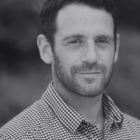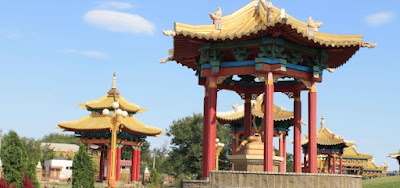The Dharma, sutras, and commentarial interpretations of interest to American Buddhists of all traditions with news that not only informs but transforms. Emphasis on meditation, enlightenment, karma, social evolution, and nonharming. (To contact us, leave a comment marked "private").
Thursday, April 27, 2023
Every Thursday with Jimmy Dore
Three Kinds of Desire (Ajahn Sumedho)
 |
| Sumedho (Robert Karr Jackman) |
 |
| Warm, vegan, gluten-free pizza, yum! |
- "I want to practice meditation so I can become free from my pain.
- I want to become enlightened.
- I want to become a monk or nun.
- I want to become enlightened as a lay person.
- I want to have a spouse and children and a profession.
- I want to enjoy the sense world without having to give up anything and become an enlightened arahant too."
- "I want to get rid of my suffering.
- I want to get rid of my anger.
- I’ve got this anger, and I want to get rid of it.
- I want to get rid of jealousy, fear, and anxiety."
 |
| Motherfather, shut up! I want to be rid of... |
 |
| Hey, what if we calm down and fix it? |
- To read more, download Ajahn Sumedho’s book The Four Noble Truths for FREE on Buddhanet.net
Thursday, April 20, 2023
Friday, April 14, 2023
Coachella (FREE livestream)
Thursday, April 13, 2023
Wednesday, April 12, 2023
The Four Absorptions (Ajahn Brahm)
Support the BSWA in making Buddhist teachings available for free online via Patreon: patreon.com/BuddhistSociety... Recorded at Dhammaloka Buddhist Centre, Perth, Western Australia. Buddhist Society of Western Australia’s teaching's page: bswa.org/teachings. To find the playlist from buddhistsocietywa, click on 'Playlists' in the top menu bar.
Sunday, April 9, 2023
Buddhist Women at the Time of the Buddha
While every effort has been made by the translator, Sister Vajira, to conform to the original writing, some changes had to be made for the sake of clarity.
The stories of the famous Buddhist nuns Bhadda Kundalakesa and Patacara have been enlarged and filled in.
Grateful acknowledgment is made to the Australian monk Ven. Khantipalo for his assistance in improving the style and content of this narrative.
His new translations of verses of the Therigatha and the Dhammapada from the original Pali language have helped to make these stories come alive.
It is hoped that this booklet will serve as an inspiration to all those who are endeavoring to tread in the Buddha's footsteps.
- Sister Khema, Wat Buddha Dhamma, Wisemans Ferry, N.S.W. 2255, Australia, Jan. 1982
- Hellmuth Hecker (dailynews.lk/line/hellmuth-hecker)
With subtle veils adorned,
Garlands and sandalwood bedecked,
Covered all over with ornaments,
Surrounded by my servants,
Taking with us food and drink,
Eatables of many kinds,
Setting off from the house,
To the forest grove we took it all.Having enjoyed and sported there,
We turned our feet to home
But on the way I saw and entered
Near Saketa, a monastery.
Seeing the Light of the World
I drew near, bowed to him;
Out of compassion the All-Seeing One
Then taught me Dharma there.Hearing the words of the Great Sage,
I penetrated Truth:
The Dharma passionless,
I touched the Dharma of Deathlessness.
When the True Dharma had been known,
I went forth to the homeless life [as a nun];
The three True Knowledges are attained,
Not empty are the Buddha's Teachings!(Therigatha 145-150) Verses of the Elder nuns. More
- Foreword
- Abbreviations
- The Verses of Final Knowledge of Bhikkhuni Sujata
- Queen Mallika
- What Cannot Be Got: The Buddha's Words to King Pasenadi on Queen Mallika's Death
- Khema of Great Wisdom
- Bhadda Kundalakesa, the Former Jain Ascetic
- Kisagotami, the Mother with the Dead Child
- Sona, With Many Children
- Nanda, the Half-sister of the Awakened One
- Queen Samavati
- Patacara, Preserver of the Vinaya
A .... Anguttara Nikaya
D .... Digha Nikaya
Dhp .... Dhammapada
M .... Majjhima Nikaya
S .... Samyutta Nikaya
Sn .... Sutta Nipata
Thag .... Theragatha
Thig .... Therigatha
Pac. .... Pacittiya (Vinaya)
J. .... Jataka
Ud. .... Udana
Mil. .... Milindapañha
Jtm. .... Jatakamala
Bu. .... Buddhavamsa
Divy..... Divyavadana
Ap. .... Apadana
The first Buddhist "meditation" (jhana)
- 00:00 Intro
- 01:40 Historical background
- 04:25 Controversies over how to understand jhāna
- 05:38 Definition of the first jhāna
- 07:03 The role of the Five Hindrances
- 09:25 Seclusion
- 10:16 Pīti and sukha
- 11:29 Vitakka and vicāra
- 14:21 The simile for the first jhana
- 15:24 Role of “form” or the body
- 16:26 Active nature of the state
What's the second meditation or jhana like?
The old Buddhists of Europe (video)
 |
| The grand Buddhist temple in Elista, Kalmykia, is full of European devotees. |
 |
| What the Buddha taught is True! |
 |
| Kalmyk girl dressed in Russian fashion |
- PHOTO: Kalmyk girl, wearing a red dress decorated with white lace and a head bonnet, typical of the Russian fashion of that time.
 |
| Map showing where the Kalmyk region is situated in the Ural Mountains |
National Poetry Month reading, LA (4/29)
- Event type: Author/Talks. Literature & Poetry
- Saturday, April 29, 2023, 11:00 AM–1:00 PM
- Audience: Free, all-ages welcome
- Home: Altadena Poetry Review
- Events: Altadena Libraries (altadenalibrary.org)
- Main Library Main Floor
- LIVESTREAMED at YOUTUBE.COM/ALTADENALIBRARY
 |
| Native US poet laureate |
 |
| Erika L. Sanchez makes an impact. |
- Audience: Adults
- Event Type: Literature & Poetry. Performance
- Tuesday, April 4, 2023, 6:00 PM–8:00 PM
- Main Library Community Room
A Buddhist Easter (video)
Saturday, April 8, 2023
Jews keep attacking Christians in Israel
 |
| Toppled statue in Church of the Flagellation, Jerusalem 2/2/23 (Custody of the Holy Land) |
As Jews attack Christians and this becomes more frequent, a crisis looms for Israel.
 |
| Journalist Lazar Berman |
Christian church leaders point to an inhospitable political atmosphere as they lock compounds at night; government ministries insist they are actively combating ill-treatment.
- Under Israeli Dictator Netanyahu, violence against Christians by Jews is being normalized (msn.com)
- On Easter, some Christians become targets for persecution
- IMAGES: The vandalized sanctuary of the Beit Jamal Monastery seen on September 22, 2017 (Latin Patriarchate of Jerusalem).
- Catholic leaders, including Custos Francesco Patton (left), stand around a vandalized statue of Jesus, March 24, 2023 (Filippo De Grazia).
- Hosam Naoum, a Palestinian Anglican bishop, pauses where vandals desecrated more than 30 graves at a historic Christian Protestant cemetery on Jerusalem's Mount Zion in Jerusalem, January 4, 2023 (AP Photo/ Mahmoud Illean).
- Illustrative -- In this Oct. 9, 2016 photo, Armenian priests arrive for Sunday mass at the Church of the Holy Sepulchre during its renovation in Jerusalem's Old City (AP Photo/Oded Balilty).
- The word "revenge" is graffitied in Hebrew on a wall in the Armenian Quarter of Jerusalem's Old City, January 11, 2022 (Armenian Patriarchate).
“If you are a Christian in the Middle East, there’s only one place where you are safe,” claims [Dictator] Prime Minister Benjamin Netanyahu, speaking to Christian Zionists in Rio de Janeiro [way back] in Dec. 2018. [The story has changed, and he's not mentioning the change to Christians.]
“There’s only one place where the Christian community is growing, thriving, prospering. That’s in the State of Israel.”
Netanyahu’s claim is a central element of the image Israeli officials put forward about the country when speaking to Western audiences.
Ahead of Christmas 2022, Israel’s official Twitter account posted a video of the Foreign Ministry’s Digital Diplomacy Chief David Saranga on a “magical Christmas stroll” through Jerusalem’s Old City.
State of Jerusalem: The "Secular" Struggle
The picture of safe coexistence painted by Israeli officials is starkly at odds with the experiences Jerusalem’s Christian leaders themselves describe.
While they readily acknowledge that there is no organized or governmental effort against them, Christian clergy in the Old City tell of a deteriorating atmosphere of harassment, apathy from authorities, and a growing fear that incidents of spitting and vandalism could turn into something far darker.
And with Netanyahu already under scrutiny from Western allies over [draconian] policies toward the Palestinians and attempts at sweeping judicial [changes labeled] reform, deteriorating safety for Christians — or at least Church leaders disseminating that narrative — could become another serious diplomatic problem for Israel’s embattled government. More + GRAPHIC IMAGES
- Truth about Israel and Netanyahu?
- BIPOC Doing Racism: Rapist brags (Twitter)
- Pacifica Archives (KPFK 90.7 FM)
Code Pink, Trump is distraction, US economy
- CODE PINK: Women for Peace
- VeteransforPeace.org
- JewishVoiceforPeace.org
- MORE Jimmy Dore videos: jimmydore.com
How I see the USA after years in Europe
- 🇺🇸 USA vs. Europe: USA vs. Europe: L...
- 🇳🇱 Dutch Culture Shocks: What are the biggest...
Man Who Doesn't Sleep: Visit to Vietnam
ChatGPT has a startup (that's not doing well)
 |
| That startup run by ChatGPT doesn't seem to be doing so great (futurism.com) |
Friday, April 7, 2023
Humans used drugs in cave rituals 3K years ago

 |
Evidence was found inside Es Càrritx cave, island of Menorca (Sarah Michals/Shutterstock) |
 |
| 3K-y.-o. red hair (Scientific Reports/Nature) |
 |
| Menorca Island, Spain |










